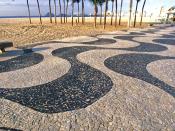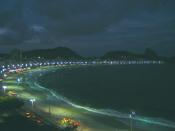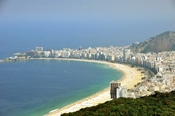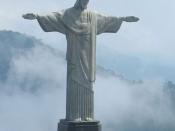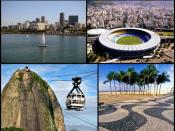Beyond Carnival, Male Homosexuality in Twentieth Century Brazil, author James N. Green focuses on Brazilian masculinity during the Vargas era. This novel deals with the late nineteenth century to the rise of the politicized gay and lesbian rights movement in the 1970s. Green's study focuses on male homosexual subcultures in Rio de Janeiro and San Paulo. He uncovers the stories of men coping with arrests and street violence dealing with family restrictions and resisting both a hostile medical profession and moralizing influences of the Church. Green also describes how these men have created vibrant subcultures with alternative support networks for maintaining romantic and sexual relationships and for surviving in an intolerant social environment. He then goes on to trace how urban parks, plazas, cinemas and beaches are appropriated for same sex encounters, which leads to a world of street cruising, male hustlers and cross-dressing prostitutes.
Green gives us a good understanding of gay male Brazilians and all the hype around "homosexuality."ÃÂ
He uses seventy interviews with a montage of illustrations from across the twentieth century. As Green notes, "whoever gets to know Copacabana, doesn't want to live anywhere else."ÃÂ New identities can be found on the prevalent beaches in Rio de Janeiro. Green describes a gay man, Agildo Guimaraes a native to Pernambuco, as having severe depression. He was suffering from an emotional crisis in which he could not stop crying. He was not happy with himself and so he moved to Rio de Janeiro where he became comfortable with himself and his health improved. It is understandable why homosexuals would fell comfortable in the popular Copacabana beach in Rio de Janeiro where homosexual behavior is the way of life. As Green says, "middle-class homosexuals or those who aspired to that lifestyle sought out Copacabana because it offered a privileged space for entertainment, cruising and socializing."ÃÂ Copacabana is an attractive place for men from poor backgrounds seeking upwards mobility. And men such as middle and upper class homosexuals who like "real"ÃÂ working men can find their significant other while cruising in the downtown areas.
Though it was not always such an open society for homosexuals like it is today. If one were to dress unconventionally it could lead to hospilization. For example, Green explains, "a father putting his son in a mental institution because "the young man was excessively concerned about his looks, spent four or five hours in the bathroom fixing himself up, and stayed out late all night."ÃÂ and "according to his medical report in the mental hospital file, the young lawyer used lipstick, a toupee, and shaved the hair on his chest and abdomen. The administering physician ordered electroshock treatment for six weeks in order to correct his behavior."ÃÂ Though not all men were openly admitted to their sexuality. In fact, some avoided those areas of the city where they might be recognized and given the stigma of "immoral"ÃÂ and "improper"ÃÂ behavior and thus seen as outsiders.
Gender roles are still a main factor today in Brazil's overall racial hierarchy. For example, the middle-class men of European ancestry may have enjoyed sexual liaison with lower-class men who where of African backgrounds or mixed backgrounds and these relationships were organized around economic power and social statis. We might say that not everyone in Brazil holds racists beliefs. It may be true, but through history the country is built upon the "foundations of a racial democracy merely submerged and recognition of the ways that skin color can determine social positioning"ÃÂ and because of this, "sexual and social interactions between members of different racial and socioeconomic groups have occurred, sharp class. Divisions and racial hierarchy have precluded substantial integration."ÃÂ The social circle among homosexuals exists not only in Brazil, but in the United States. Green gives us an idea of being gay in the United States during the 1940s and 1050s compared to Brazil. The United States seems the same when comparing the meeting places and the socializing among gay men. Night clubs are used as a chance to communicate with others about their romances, friendships and adventures. As in Brazil, the gay men in the United States had to lead a double life by staying a way from stigmas. As Green stated, "in real life, it was necessary to hide one's true self, since overt displays of effeminate behavior or references associated in the popular culture with homosexuality would have resulted in social stigmatization, barriers to employment, and embarrassment to respectable families."ÃÂ But among friends in their circle they could be themselves without the pressures of having to conform to strict social standards. Both the United States and Brazil have similarities when comparing the gay lifestyle. In particular, Green says, "building a social network of friends was crucial for surviving as a homosexual in the United States in the early 1950s. This was equally the case in Brazil, where small groups of friends were the foundation of subculture. Public spaces, such a parks, cinemas, beaches, and certain streets provided opportunities to meet friends, make new acquaintances and find sexual partners."ÃÂ This book was very interesting because it really was "beyond carnival."ÃÂ Green gives us an understanding of how homosexuality will not be found in the Carnival celebration in Rio de Janeiro. Since the 1870s there have been new meeting places like the Copacabana and some places that are more hidden only for "native homosexuals"ÃÂ to find. It is not surprising why a society would exclude homosexuals, because a society gives a stigma to anyone that is different from the "norm."ÃÂ It is still interesting, however, how society can influence one's sexual behaviors.
